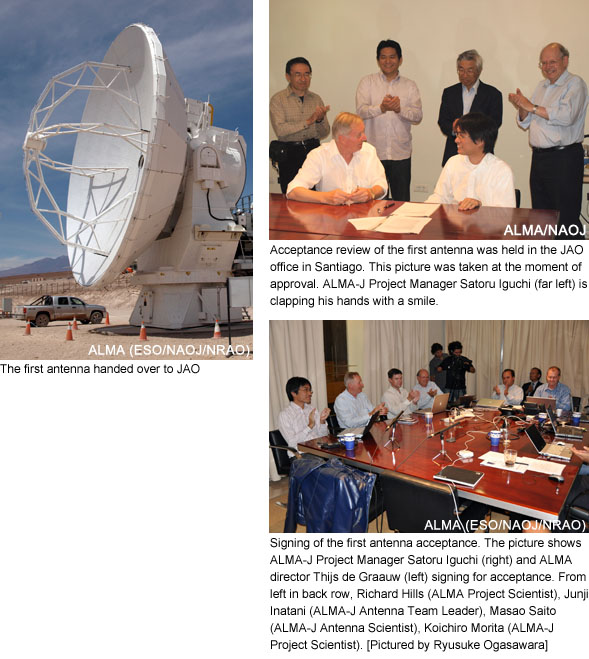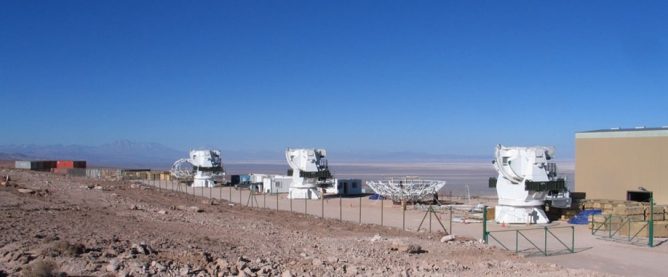Japanese ALMA antenna became the first to arrive at the ALMA 5000 m site.
Japanese ALMA antenna became the first to arrive at the ALMA 5000 m site. The ALMA (Atacama Large Millimeter/submillimeter Array) astronomical observatory has taken another step forward and upward, as one of its state-of-the-art antennas was carried for the first time to the 5000m plateau of Chajnantor, in the Chilean Andes, on the back of a custom-built giant transporter, on 2009 September 18 (JST). The antenna, which weighs about 100 tons and has a diameter of 12 meters, was lifted to the high-altitude Array Operations Site, where the extremely dry and rarefied air is ideal for ALMA’s observations of the universe.
The conditions at the Array Operations Site on Chajnantor, while excellent for astronomy, are also very harsh. Only half as much oxygen is available as at sea level, making it very difficult to work there. This is why ALMA’s antennas are assembled and tested at the lower 2900 m altitude of the ALMA Operations Support Facility (OSF). It was from this relatively hospitable base camp that the ALMA antenna began its journey to the high Array Operations Site.
The ALMA antennas use state-of-the-art technology, and are the most advanced submillimeter-wavelength antennas ever made. They are designed to operate fully exposed in the harsh conditions of the Array Operations Site, to survive strong winds, and to keep their smooth reflecting surfaces accurate to at least 25 micrometers (less than the typical thickness of a human hair) under a wide range of air temperature of -20 to +20 degrees. The high precision antenna has been extensively evaluated at OSF. In addition to the antenna tests as a single unit, an interferometer test was conducted as one element of the array, and a beautiful interference fringe was successfully obtained by receiving the radio waves from the planet Mars. Now it’s time to bring the antenna to the high site to evaluate the actual performance at the place where astronomical observations will be conducted.
-

- A Japanese ALMA Antenna being transported to the ALMA 5000 m site.
-

- A Japanese ALMA Antenna being transported to the ALMA 5000 m site.
-

- A Japanese ALMA Antenna being transported with the ALMA transporter.
-

- A Japanese ALMA Antenna being transported with the ALMA transporter.
“Today, the first antenna, manufactured by Japan, was moved to the AOS at 5000 meters above sea level. As ALMA is a global partnership, we have coped with various difficulties due to differences in culture and language. However, we could reach here, thanks to the cooperation of the JAO staff working in Chile, NAOJ staff who worked hard for the evaluation of the antenna, and the Japanese vendor supporting the performance of the antenna,” said Satoru Iguchi, East Asian ALMA Project Manager
The trip began when one of the two ALMA transporters lifted the antenna onto its back, carrying its heavy load along the 28 km road from the Operations Support Facility up to the Array Operations Site. While the transporter is capable of speeds of up to 12 km/hour when carrying an antenna, this first journey was made more slowly to ensure that everything worked as expected, taking about seven hours.
“Transporting our first antenna to the Chajnantor plateau is a epic feat which exemplifies the exciting times ALMA is living. Day after day, the force of our global collaboration brings us closer to the birth of the most ambitious ground-based astronomical observatory in the world”, says Thijs de Graauw, ALMA Director.
Once the transporter reached the high plateau it carried the antenna to a concrete pad — a docking station with connections for power and fibre optics — and positioned it with an accuracy of a few millimeters. The transporter is guided by a laser steering system and, just like some cars today, also has ultrasonic collision detectors. These sensors ensure the safety of the state-of-the-art antennas as the transporters drives them across what will soon be a rather crowded plateau. Ultimately, ALMA will have a total of 66 antennas distributed over about 200 pads, spread over distances of up to 18.5 km and operating as a single, giant telescope.
This first ALMA antenna at the high site will soon be joined by others, and the ALMA team look forward to making their first observations from the Chajnantor plateau. They plan to link three antennas by early 2010, and to start regular scientific observations with ALMA in 2012.
The telescope will observe the universe at millimeter and submillimeter wavelengths, between infrared light and radio waves in the electromagnetic spectrum. Millimeter/submillimeter waves are emitted by some of the coldest and most distant objects in the cosmos. These include cold clouds of gas and dust where new stars are being born, or remote galaxies towards the edge of the observable universe. ALMA will explore the unknown region of the universe with the most advanced technologies.
-

- A Japanese ALMA Antenna installed on the ALMA 5000m site with the ALMA transporter.
About ALMA
The Atacama Large Millimeter/submillimeter Array (ALMA), an international astronomy facility, is a partnership of East Asia, Europe, and North America in cooperation with the Republic of Chile. NAOJ is the East Asia partner in ALMA. ALMA, the largest astronomical project in existence, is a revolutionary telescope, comprising an array of 66 or more giant 12-meter and 7-meter diameter antennas observing at millimeter and submillimeter wavelengths. ALMA will start regular scientific observations in 2012.
More information about ALMA: http://www.almaobservatory.org/









